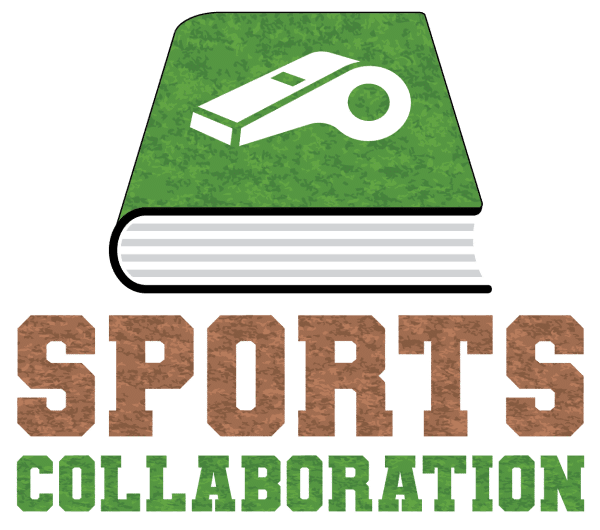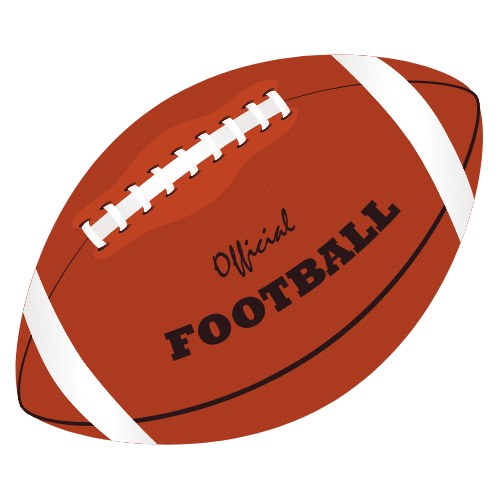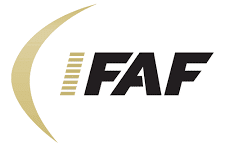Rule 1 - The Game, Field, Players and Equipment
SECTION 2. The Field
Article 1 - Dimensions and Markings
The field shall be a rectangular area with dimensions, lines, zones, goals and
pylons as indicated in Appendix D.
a. Where the size of the stadium does not permit a full-sized field to be marked, game management may use an IFAF yard as the unit of measurement.
1. An IFAF yard is normally 36 inches (91.44cm) long, but may be shortened to no less than 34.12 inches (86.67cm) only if necessary to fit a 100-yard field of play plus two 10-yard end zones within the available playing surface.
2. If the length of the field is reduced by an IFAF yard factor, all other field dimensions and markings stated in these rules shall be reduced commensurately (Exception: The length of the hash marks and the width of lines). The length of the yardage chain (Rule 1-2-7) shall also be reduced to correspond to the markings on the field.
b. All field-dimension lines shown must be white and 4 inches in width. (Exceptions: Sidelines and end lines may exceed 4 inches in width, goal lines may be 4 or 8 inches in width, and Rule 1-2-1-h).
c. Twenty-four-inch short yard-line extensions, four inches inside the sidelines and at the hash marks, are mandatory and all yard lines shall be four inches from the sidelines (Rule 2-12-6).
d. A solid white area between the sideline and the coaching line is mandatory.
e. White field markings or contrasting decorative markings (e.g. team names) are
permissible in the end zones but shall not be closer than four feet to any line.
f. Contrasting colouring in the end zones may abut any line.
g. Only these contrasting decorative markings are allowed: competition logo, and team name and logo. These are permissible within the sidelines and between the goal lines, under these conditions: (See Appendix D):
1. The entirety of all yard lines, goal lines and sidelines must be clearly visible. No portion of any such line may be obscured by decorative markings.
2. No such markings may touch or enclose the hash marks or numbers.
3. A single decorative marking, centered on the midfield line, and a maximum of four smaller flanking decorative markings are allowed.
h. Goal lines may be of one contrasting colour from the white lines.
i. Advertising is permissible on the field, providing it meets the requirements of Rules 1-2-1-e, 1-2-1-f and 1-2-1-g.
j. White field yard-line numbers not larger than 6 feet in height and 4 feet in width, with
the tops of the numbers nine yards from the sidelines, are recommended.
k. White directional arrows next to the field numbers (except at midfield) indicating the direction toward the nearest goal line are recommended. The arrow is a triangle with an 18-inch base and two sides that are 36 inches each.
l. The two hash marks are 60 feet from the sidelines. Hash marks and short yard-line extensions shall measure 24 inches in length.
m. Nine-yard marks 12 inches in length, every 10 yards, shall be located nine yards from the sidelines. They are not required if the field is numbered according to Rule 1-2-1-j.
n. In an indoor stadium, the roof shall be no less than 90 feet above the field.
o. If played in a stadium with a retractable roof, game management shall decide 90 minutes before kickoff whether to play the game with the roof open or closed. The roof must be closed if (from 90 minutes before the game until the end of the game)
precipitation or lightning is within the vicinity of the stadium, the temperature drops below 40°F (4°C), or wind gusts are greater than 40 miles per hour (64 km/h). Once the roof is closed, it is not allowed to be reopened during the game.
Article 2 - Marking Boundary Areas
Measurements shall be from the inside edges of the boundary markings. The entire width of each goal line is in the end zone.
Article 3 - Limit Lines
a. Limit lines shall be marked with 12-inch lines and at 24-inch intervals 18 feet outside the sidelines and the end lines, except in stadiums where the total field surface does not permit. In these stadiums, the limit lines shall not be less than six feet from the sidelines and end lines. Limit lines shall be 4 inches in width and may be yellow. Limit lines designating team areas shall be solid lines.
b. No person outside the team area shall be inside the limit lines. Game management personnel have the responsibility and the authority to enforce this rule. (Exception: Hand-held cameras under the supervision of the television partners may briefly be
between the limit lines and the sideline after the ball is dead and the game clock has been stopped. This exception does not allow cameras to be on the field of play or in the end zone at any time.)
c. Limit lines shall also be marked six feet from the team area around the side and back of the team area, if the stadium permits.
Article 4 - Team Area and Coaching Box
a. On each side of the field, a team area behind the limit line and between the 20-yard lines shall be marked for the exclusive use of substitutes, athletics trainers and other persons affiliated with the team. The front of the coaching box shall be marked with a solid line six feet outside the sideline between the 20-yard lines. The area between the coaching line and the limit line between the 20-yard lines shall contain white diagonal lines or be marked distinctly for use of coaches (Rule 9-2-5). A 4-inch-by-4-inch mark is mandatory at each five-yard line extended between the goal lines as an extension of the coaching line for line-to-gain and down indicator six-foot reference points.
b. The team area shall be limited to squad members in full uniform and a maximum of 25 other individuals directly involved in the game. All persons in the team area are subject to the rules and are governed by decisions of the officials (Rule 1-1-6). The 25
individuals not in full uniform shall wear special team area credentials. No other credential is valid for the team area. Medical personnel are exempted from the 25-credential limit and should have a separate, distinct pass.
c. Coaches are permitted in the coaching box (see Appendix D), which is the area bounded by the limit line and coaching line between the 20-yard lines.
d. No media personnel, including journalists, radio and television personnel, or their equipment, shall be in the team area or coaching box, and no media personnel shall communicate in any way with persons in the team area or coaching box. In stadiums where the team area extends to the spectator seating area, a pass-through area should be made available for media to move from one end of the field to the other on both sides of the field.
e. Game management personnel shall remove all persons not authorised by rule.
f. Practice kicking nets are not permitted outside the team area (Exception: In stadiums where playing enclosures are limited in size, nets, holders and kickers are permitted outside the team area and outside the limit line) (Rule 9-2-1-b-1).
Article 5 - Goals
a. Each goal shall consist of two white or yellow uprights extending at least 30 feet above the ground with a connecting white or yellow horizontal crossbar, the top of which is 10 feet above the ground. The inside of the uprights and crossbar shall be in the
same vertical plane as the inside edge of the end line. Each goal is out of bounds (see Appendix D).
b. Above the crossbar, the uprights shall be white or yellow and 18 feet, six inches apart inside to inside.
c. The designated uprights and crossbar shall be free of decorative material (Exception: 4-inch-by-42-inch orange or red wind directional streamers at the top of the uprights are permitted).
d. The height of the crossbar shall be measured from the top of each end of the crossbar to the ground directly below.
e. Goal posts shall be padded with resilient material from the ground to a height of at least six feet. Advertising is prohibited on the goals. One manufacturer’s logo or trademark or an advertisement is permitted on each goal post pad. Team/national and competition logos are allowed. All padding is out of bounds.
f. The following procedure will be adopted when one or both goals are missing or have been taken down and the original goals are not available for a try or field goal attempt:
1. If a portable goal is available, it shall be erected or held in place at the request of Team A.
2. If a portable goal is not available but one goal is in place:
(a) On all scrimmage plays, Team B shall defend the end of the field where the goal is situated.
(b) On all free kick plays, Team A shall defend the end of the field where the goal is situated.
(c) After a change of possession, the teams will change ends if necessary so that Team B is defending the end where the goal is situated.
(d) There will be no change of ends at the end of the first or third periods (one minute timeout only). Captains will not have the option to select which goal line to defend at the beginning of a half or the start of an extra period.
3. Alternatively, if one goal is (or becomes) missing or unusable, the game may proceed (or resume) without using the other goal, if both head coaches agree. In these circumstances no further field goals shall be scored. Once stated, the coaches’ decisions as to whether to proceed without goals shall be irrevocable.
4. If no goals are available, the game may be played if both head coaches agree. In these circumstances no field goals shall be scored. If one or both head coaches do not wish to play, then the game shall be abandoned. Once stated, the coaches’ decisions
as to whether to start/continue shall be irrevocable.
Article 6 - Pylons
Soft flexible four-sided pylons 4 inches by 4 inches with an overall height of 18 inches, which may include a two-inch space between the bottom of the pylon and the ground, are required. They shall be red or orange in colour. One manufacturer’s logo or
trademark is permitted on each pylon. Team/national logos, competition logos and the name/commercial logo of the title sponsor of the game are also allowed. Any such marking may not extend more than 3 inches on any side. They are placed at the inside corners of the eight intersections of the sidelines with the goal lines and end lines. The pylons marking the intersections of the end lines and hash marks extended shall be placed three feet off the end lines.
a. A displaced pylon is one that is no longer in its proper position. Unless it is obvious that at least some part of the pylon is touching the ground in the 4-inch by 4-inch square that is its proper position, the pylon is no longer a pylon for the purposes of the rules (e.g. Rule 8-2-1-a). A displaced pylon may be restored to its proper position at any time.
b. Touching a displaced pylon that is partially or completely out of bounds makes the ball or player out of bounds (Rule 4-2).
c. A displaced pylon that is completely inbounds is no longer a pylon and is to be considered as part of the playing surface.
d. A displaced goal line pylon that is partially in its proper position is still to be regarded as a goal line pylon for the purposes of the rules. Only parts of a displaced pylon that are behind the vertical plane of the goal line are behind the goal line.
e. If a goal line pylon cannot be stood upright, it should be positioned so that it lies on the goal line extended out of bounds with its base covering the sideline.
f. If an end line pylon cannot be stood upright, it should be positioned so that it lies on the sideline extended out of bounds with its base covering the end line.
Article 7 - Line-to-Gain and Down Indicators
The official line-to-gain (yardage chain) and down indicators shall be operated approximately six feet outside the sideline, except in stadiums where the total playing enclosure does not permit. These must be operated on the side of the field opposite the press box.
a. The yardage chain shall join two rods not less than five feet high, the rods’ inside edges being exactly 10 yards apart when the chain is fully extended.
b. The down indicator shall be mounted on a rod not less than five feet high operating approximately six feet outside the sideline opposite the press box.
c. An unofficial auxiliary line-to-gain indicator and an unofficial down indicator six feet outside the other sideline are recommended.
d. Unofficial red or orange non-slip line-to-gain ground markers positioned off the sidelines on both sides of the field are recommended. Markers are rectangular, weighted material 10 inches by 32 inches. A triangle with an altitude of five inches is attached to the rectangle at the end toward the sideline.
e. All line-to-gain and down-indicator rods shall have flat ends.
f. Advertising is permitted on the down and line-to-gain indicators. One manufacturer’s logo or trademark is permitted on each indicator. Team/national and competition logos are allowed.
Article 8 - Markers or Obstructions
a. All markers and obstructions within the playing enclosure shall be placed or constructed in such a manner as to avoid any possible hazard to players. This includes anything dangerous to anyone at the limit lines.
b. After the officials’ pregame inspection of the playing enclosure, the referee shall order removed any hazardous obstructions or markers located inside the limit lines.
c. The referee shall report to game management personnel any markers or obstructions constituting a hazard within the playing enclosure but outside the limit lines. Final determination of corrective action shall be the responsibility of game management
personnel.
d. After the officials have completed their pregame inspection of the playing enclosure, it is the responsibility of game management personnel to ensure that the playing enclosure remains safe throughout the game.
e. Yardage line markers must be placed at least 12 feet outside the sidelines and should be collapsible and constructed in such a manner as to avoid any possible hazard to players. Yardage line markers on the goal lines must be placed at least 18 feet outside the sideline. Markers which do not conform to this standard shall be removed. Advertising on yardage line markers is permitted.
Article 9 - Field Surface
a. No material or device shall be used to improve or degrade the playing surface or other conditions and give one player or team an advantage (Exception: Rules 2-16-4-b and 2-16-4-c).
PENALTY − Live-ball foul. Five yards from the previous spot [S19: APS].
b. The referee may require any improvement in the field necessary for proper and safe
game administration.



